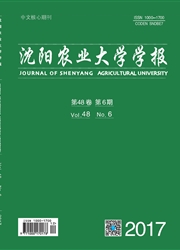

 中文摘要:
中文摘要:
应用LI-6400便携式光合测定系统对金银忍冬(Loniccra maackii)和榆叶梅(Prunus triloba)春季光合作用的日变化规律进行研究,利用SPSS统计分析软件,采用相关分析及回归分析得出净光合速率与光合有效辐射、气温、大气湿度、气孔导度等生理生态因子间的相关关系。结果表明:金银忍冬春季光合速率呈双峰曲线,17:00出现一个小高峰,影响光合速率的主要因子为气孔导度(G1)、光合有效辐射(PAR)、大气相对湿度(RH)、胞间CO2浓度(C1);榆叶梅春季光合速率呈双峰曲线,影响光合速率的主要因子为光合有效辐射(黝R)、气孔导度(G1);金银忍冬较榆叶梅春季净光合速率大。
 英文摘要:
英文摘要:
Using LI-6400 CO2 gas analysis system and SPSS by the methods of correlation analysis and regression, this paper studied the diurnal changes of Loniccra maackii and Prunus triloba photosynthesis during Spring and assessed the correlation between net photosynthetic rate and environmental factors. The results indicated that the photosynthetic rate of Loniccra maackii showed a double-peak curve in spring , and at about 17:00pm showed a little peak. The major factors affecting the photosynthetic rate were stomatal conductance, the solar radiation,vapor rate and intercellular CO2 intensity in Spring. The photosynthetic rate of Prunus triloba showed a double-peak curve in spring too. The major factors affecting the photosynthetic rate of Prunus triloba were solar radiation and the stomatal conductance. The photosynthetic rate of Loniccra maackii was higher than that of Prunus triloba.
 同期刊论文项目
同期刊论文项目
 同项目期刊论文
同项目期刊论文
 Effects of Elevated Ozone on Photosynthetic CO2 Exchange
and Chlorophyll a Fluorescence in Leaves of
Effects of Elevated Ozone on Photosynthetic CO2 Exchange
and Chlorophyll a Fluorescence in Leaves of Influence of elevated carbon dioxide and ozone on the foliar nonvolatile terpenoids in Ginkgo biloba
Influence of elevated carbon dioxide and ozone on the foliar nonvolatile terpenoids in Ginkgo biloba Solar activity, Global Surface Air Temperature Anomaly and Pacific Decadal Oscillation signals obser
Solar activity, Global Surface Air Temperature Anomaly and Pacific Decadal Oscillation signals obser Impact of Elevated CO2 and O3 Concentrations on Biogenic
Volatile Organic Compounds Emissions from G
Impact of Elevated CO2 and O3 Concentrations on Biogenic
Volatile Organic Compounds Emissions from G 期刊信息
期刊信息
